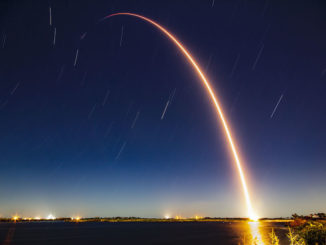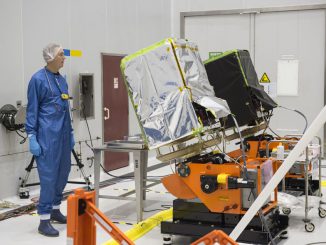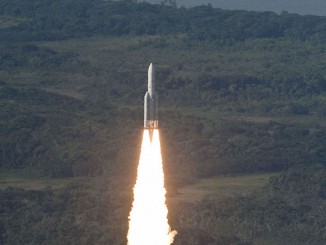
SpaceX completed its second mission bound for the International Space Station this month. But unlike all previous missions targeting the orbiting outpost, this flight didn’t feature a Dragon spacecraft.
At 12:07 p.m. EST (1707 UTC) SpaceX launched a Cygnus spacecraft on behalf of Northrop Grumman as part of NG’s 20th Commercial Resupply Services (CRS) contract mission for NASA using its Falcon 9 rocket.
The rocket launched from Space Launch Complex 40 (SLC-40) at Cape Canaveral Space Force Station (CCSFS) against a clear blue sky as a backdrop.
The Falcon 9 first stage booster supporting this mission, tail number B1077, made its 10th flight. It previously launched the Dragon Endurance for the Crew-5 flight, the SpaceX CRS-28 mission as well as four Starlink flights.
A little over eight minutes after liftoff, B1077 touched down at Landing Zone 1 at CCSFS. Those watching the launch from Florida’s Space Coast or other parts of Central Florida may have heard a sonic boom as the booster is reentering the atmosphere during the landing.
This will mark the 35th booster landing at LZ-1, the 44th land landing for SpaceX in Florida and the 269th Falcon 9 booster landing to date.
Many firsts
The launch of the NG-20 mission marked a number of milestones for all players involved. As previously mentioned, this was the first time a SpaceX Falcon 9 rocket launched a Cygnus spacecraft for Northrop Grumman.
In a prelaunch briefing with reporters, Bill Gerstenmaier, SpaceX’s vice president of Build and Flight Reliability, remarked on the first of three planned missions for NG.
“It’s a tremendous honor to be part of this team. It’s a neat effort to see how all the spaceflight participants come together,” Gerstenmaier said.
Because the Cygnus spacecraft needs to be accessible for cargo to be loaded somewhat last minute, Gerstenmaier said SpaceX made some modifications to the Falcon 9’s payload fairings to make that possible.
He said these fairings include a five-foot by four-foot wide door, which he described as “more than just a hatch.”

“It’s actually an environmentally controlled area, so we don’t bring any type of debris or contamination in,” he explained. “The front part of Cygnus is very sensitive, as it berths the station. There are some rings that seal it to the space station. We cannot contaminate those rings. We have to make sure the cargo is delivered safely through this door, into the fairing and then carefully placed inside Cygnus for launch.”
He said the door is located near the bottom of the payload fairings. He said on Monday night, a truck backed up to the fairings with a platform that attached to the outside of the fairing that would allow workers to go up through the door.
“We at SpaceX like to do innovative and creative things. So, you can give us the challenge and tell us you need us to cut a five-foot by four-foot hole on the fairing and we figure out a way to go do that,” Gerstenmaier said. “The fairing is still recoverable, just as they were before.”

Cyrus Dhalla, the vice president and general manager of Tactical Space Systems at Northrop Grumman, said they didn’t have to make any modification to the Cygnus spacecraft ahead of this mission. They did adjust their loading procedures to accommodate their new ride to space.
The reason Cygnus needs the Falcon 9 to send it on its way to the ISS is because of Russia’s invasion of Ukraine. The combination of the war and the winding down of the use of Russian-made engines forced the retirement of the Antares 230+ rocket.
NG is working on its next launch vehicle, the Antares 330 in partnership with Firefly Aerospace, but that won’t be available until at least 2025.
This was also the first time since 2017 that a Cygnus spacecraft launched from the Cape. The CRS Flight 7 was the last of three such missions that called upon the launch services of United Launch Alliance’s Atlas 5 rocket.
New cargo and science
Onboard the Cygnus is more than 8,200 pounds of science and supplies for those living and working aboard the ISS. Some of the marquee science and research supplies include a surgical robot from the Virtual Incision Corporation, a semiconductor manufacturing device from Redwire Space and a metal 3D printer from the European Space Agency, among many others.
Meghan Everett, the deputy program scientist for NASA’s ISS Program, noted that there are more than 1,300 kg of mass flying up to the station that will support 46 investigations and facilities.
“The different types of science that we’re supporting here include areas of human research, technology demonstrations, fundamental science, and Earth-based observations from a lot of our external hardware,” Everett said.

About 15 minutes after launch, the Cygnus spacecraft separated from the Falcon 9’s upper stage. It’s set to arrive at the orbiting outpost at 4:20 a.m. EST on Thursday, Feb. 1. NASA astronaut Jasmin Moghbeli will use the Canadarm2 to capture the spacecraft and install it on the Unity module’s Earth-facing port.
The spacecraft will remain docked to the space station for about six months before its departs and burns up in the atmosphere. It will host one last science experiment, the Kentucky Re-entry Probe Experiment-2 (KREPE-2) on its way back, which “will take measurements to demonstrate a thermal protection system for spacecraft and their components during re-entry,” according to NASA.



